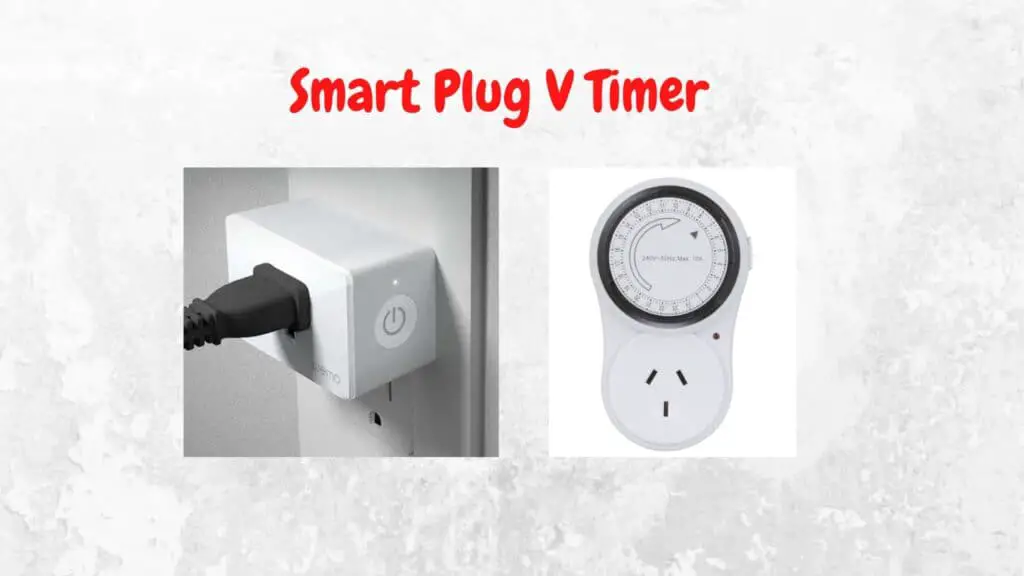They both have their perks, but what’s the difference between a smart plug v timer? Plus, which one should you choose? Below are 6 considerable differences between smart plugs and timers that could impact on your safety, energy efficiency and comfort.
This page contains affiliate links. As an Amazon Associate, I earn from qualifying purchases.
If you’re in a hurry, here is a site I recommended for office equipment with lifetime guarantee!
Smart Plug V Timer
The below table highlights the key differences between smart plugs and plug-in timers.
| Feature | Smart plug | Timer |
| Means of control | Remotely control devices on app | Controlled at source |
| Energy consumption display | Displays energy consumption | Doesn’t display energy consumption |
| Operating system | Operates via Wi-Fi and app | Operates off electricity |
| Level of programming | More sophisticated programming | Limited programming |
| Level of timing accuracy | High | Lower |
| Price | $7.73 – $39.95 | $5.49 – $22.99+ |
As you can see from above, there are some stark differences between using a smart plug and a timer. So, are smart plugs the leader of the pack? Or would a plug-in timer be sufficient? Plus, what benefits can they bring to your life? Let’s take a deeper look into each pro and con of each to find out!
A study has shown that smart plugs can save between 1 – 4.58% energy every year, equivalent to about a month of electricity! Source

Smart Plug V Timer
Control of devices
Smart plugs are controlled by an app on your phone, tablet or laptop. With the app and internet connection, you can login from virtually everywhere and program a device setting. This could include turning it on, off, setting an interval etc.
In contrast, timers need to be programmed where they are located. If you want to adjust the settings, the only way to do this is at source.
Smart plugs provide the added convenience of being able to operate hard to reach items via your app.
For instance, if you currently have a lamp on a timer and you normally have to fling yourself over the couch to reach it.
Switching it to a smart plug can avoid that acrobatic stunt and you can adjust it on your phone!
I personally think it’s a lifesaver when you need to turn the fridge freezer off to defrost it.
Recommended Product: Kasa Smart Plug Works with Alexa, Echo, Google Home (link on Amazon)
Displays energy consumption
Both smart plugs and timers enable you to operate equipment at certain times which we all know saves them being turned on for as long. This energy usage reduction can often be seen in your energy bill.
But with some of the more advanced smart plugs and smart sockets, there is an app feature which displays the energy consumption of a device.
This enables you to become more aware of how much energy devices use and how much it could be costing you to run them.
In turn, this can lead to you making more conscious decisions about what devices to use and how often to use them.
However, with plug-in timers, there’s no energy consumption display so you often you can’t tell if or how much electricity you are saving by using the timer.
Operation of plug
Smart plugs and their apps need a Wi-Fi connection to update settings and check the status of devices when away from home.
Smart plugs can run for a short period of time if the internet cuts.
However, if the internet is down at your home or office for an extended period, it can interfere with the timing and programming of the smart plug.
Plus, if you’re out and you don’t have internet, you won’t be able to use the app.
In contrast, plug-in timers simply rely on electricity to run. This makes them more reliable if you are in a room or area that has limited or poor internet connection.
Level of programming
Smart plugs have a more advanced level of programming compared to a timer. While digital timers are fairly advanced compared to mechanical timers, they still fall far short of smart plugs.
Smart plugs allow you to:
- Set countdown timers, e.g., Turn off TV in 1 hour down to the minute.
- Set customized timers, e.g., holiday mode turns lights on and off at various intervals to create the illusion that someone is home.
- Create customized scenes, e.g., dim lights in child’s bedroom at 9pm.
- Control setting by voice and app, e.g., ask Alexa to turn off kitchen lights.
- Shared control of smart plug, e.g., add or restrict multiple family members controlling a plug via app.
- Grouping devices, e.g., group smart bulbs and smart plugs in kitchen to all turn off with one click.
Mechanical timers typically allow you to:
- Set on and off timing, e.g., Christmas lights turn on at 6pm and off at 11pm.
- Set interval timing, e.g., water sprinkler to come on for 5 minutes every 5 hours.
A digital timer allows you to:
- Set up to 9 on and off timings scheduled to the minute.
- Set interval timing
- Create settings for one specific day or multiple days, e.g., turn on kettle at 7am Monday – Friday.
- Create random security settings
Tip: By grouping an outdoor light with an outdoor camera via a smart plug, you can program the light to turn on when the camera senses motion.
Level of timing accuracy
Smart plugs allow you to program down to the minute which allows a greater level of accuracy.
In contrast, some mechanical plug-in timers work through a dial which only has 15 minute or 30-minute intervals.
That means if you only want something to turn on for 10 minutes, you’ll have to leave it on for 15 or 30 minutes which is less energy efficient.
Furthermore, the cheaper mechanical plug-in timers might only enable you to set timers for 1 – 2 times a day.
On a side note, I always find those pins finicky to work. Plus, it can be confusing to set them if you’re not used to using them.
Price of smart plug v timer
Smart plugs have a price range from approximately $7.73 – $39.95. Timers start at $5.49 and can rise to $22.99+ when digital plug-in timers are considered. Consequently, the entry price makes plug-in timers marginally cheaper than smart plugs.
However, when you start looking for more advanced plugs, the smart plug can work out most expensive.
But don’t lose sight of the fact that if you use the smart plug correctly and on worthwhile devices, you should be able to offset the cost.
Ultimately, you could be in a money surplus status after a few months or a year, dependinxg on usage and the energy load of the device.
Tip: Consider opting for smart sockets instead to facilitate control over more devices.
Conclusion
Smart plugs and timers both boast a wide range of advantages, be it for home, work or leisure. They can elevate the level of control, efficiency and comfort that you have with your appliances and devices.
Realistically, if you’re looking for a highly customizable plug to control via an app and possibly integrate with your other smart home devices, the smart plug is the winner.
But if you’re happy with a plug that has a more basic functionality that works off electricity as opposed to Wi-Fi and must be controlled at source, the timer will work just as well, if not better.
If you would like to further enhance your knowledge on other accessories, I have written some articles worth a look.
Here are some other useful articles I wrote that you should go check out:
- Essential work at home gadgets – 5 must-haves!
- 7 benefits of an ergonomic mouse – With expert tips & FAQs!
- How To Choose A Smart Plug – 9 Must Know Factors!
Recommended products:
Kasa Smart Plug Works with Alexa, Echo, Google Home (link on Amazon)
Kasa Smart Light Bulbs (link on Amazon)
Kasa Smart Plug Power Strip (link on Amazon)

